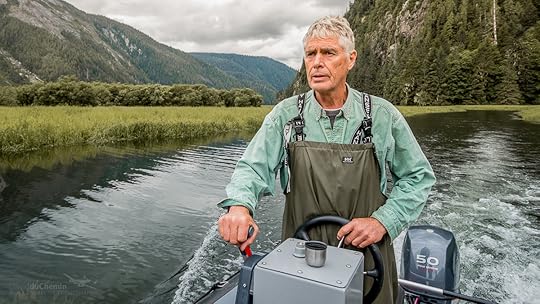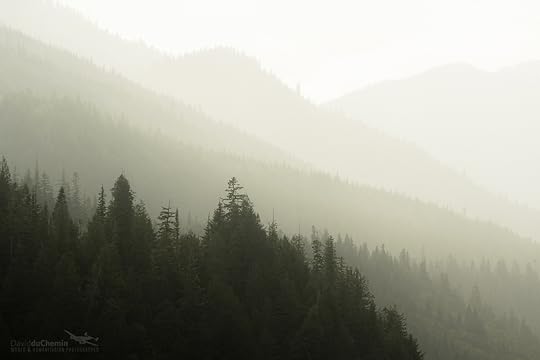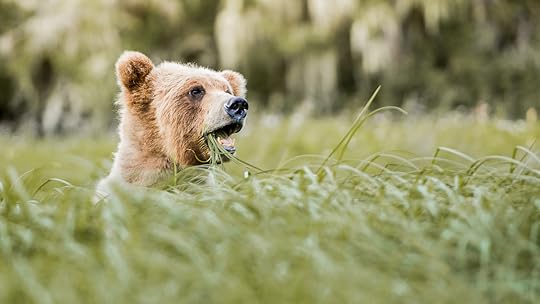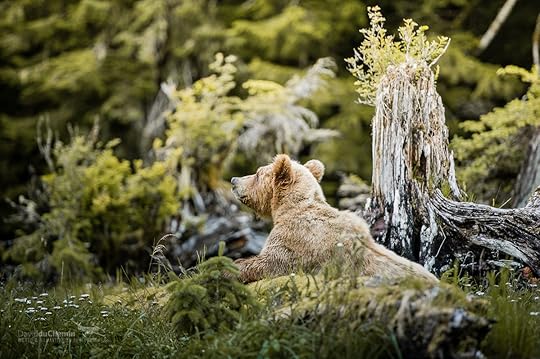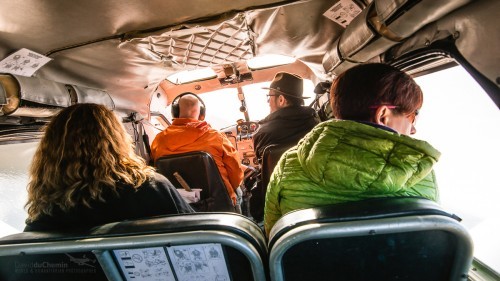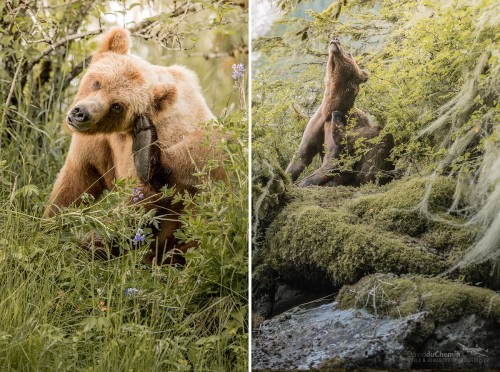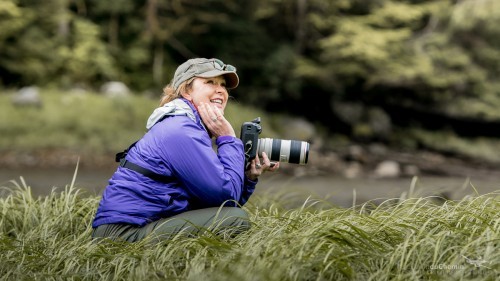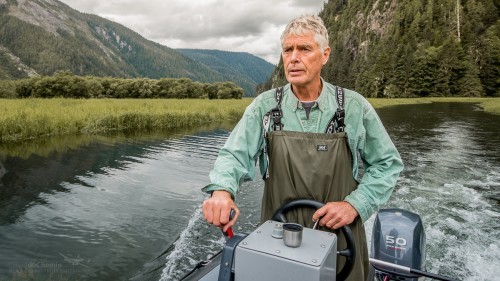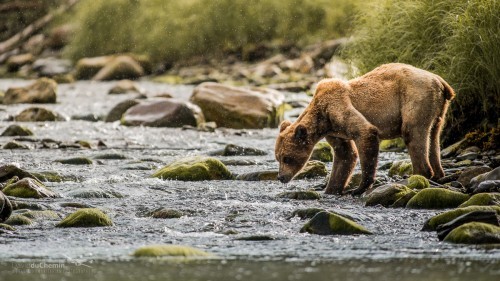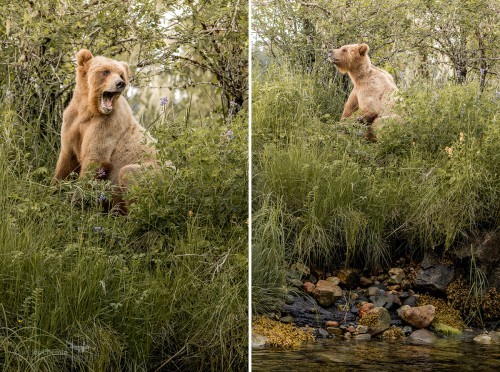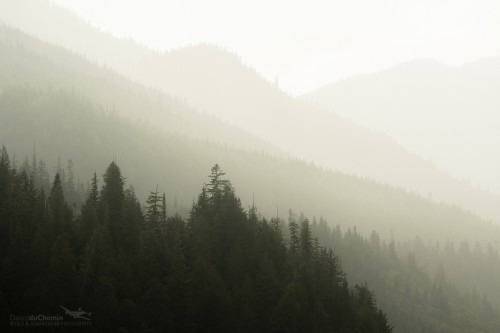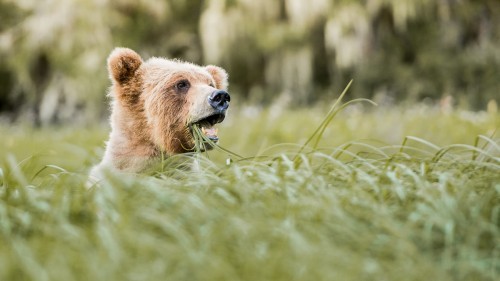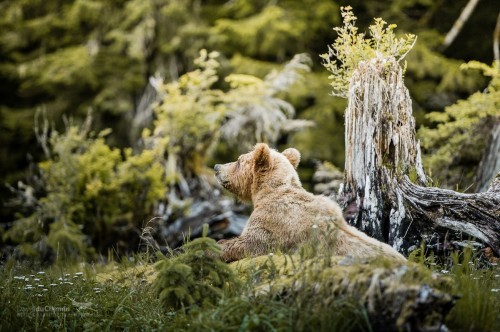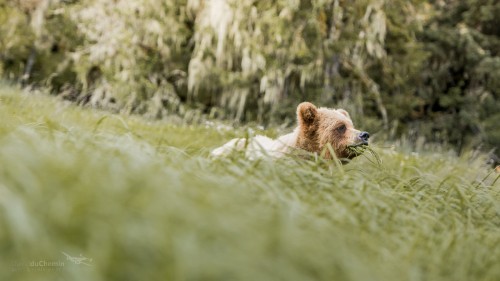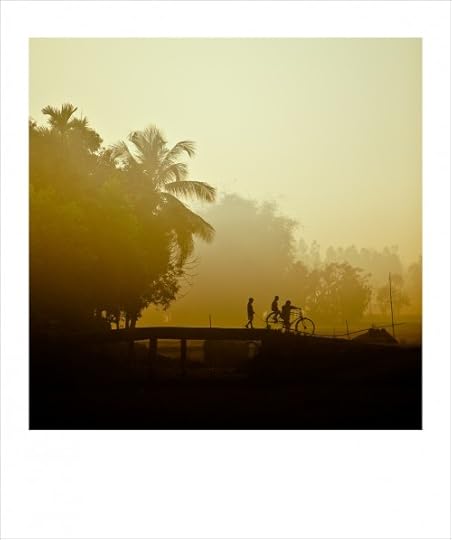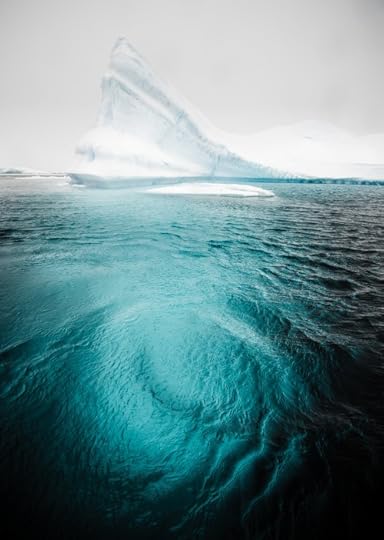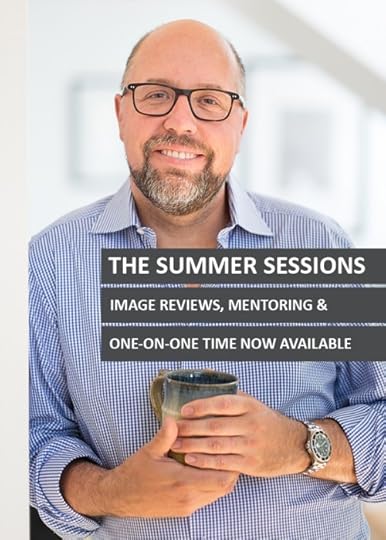David duChemin's Blog, page 16
June 19, 2015
Back in the Khutzeymateen
 Three days is not enough for these adventures, even less so when Air Canada loses your luggage en route to Prince Rupert and you’re socked in by fog the first morning, but when we finally flew into the Khutzeymateen Inlet in British Columbia’s wild west coast, and began sitting with the grizzlies from our inflatable zodiac, it’s like time just stopped. Words can’t describe what I feel for these bears and the experience of being among them, in their home, but I hope the photographs can. Four of us chartered the Ocean Light II, giving us more room in the Zodiac (there are usually 8 passengers), and the ability to work with our guide, Tom, in a much more focused way. What a time we had. The golden bear you see in most of these images was amazing. We named her Bella and sat with her for hours watching her do her thing. She was patient with us, went about her day without giving any sense she minded us there, and seemed to welcome us when we returned looking for her the next day. In between there were crab dinners and long conversations, early morning kayaking, and the indescribable peace of a 6am coffee on the deck of the boat when others have not yet pulled themselves from their bunks.
Three days is not enough for these adventures, even less so when Air Canada loses your luggage en route to Prince Rupert and you’re socked in by fog the first morning, but when we finally flew into the Khutzeymateen Inlet in British Columbia’s wild west coast, and began sitting with the grizzlies from our inflatable zodiac, it’s like time just stopped. Words can’t describe what I feel for these bears and the experience of being among them, in their home, but I hope the photographs can. Four of us chartered the Ocean Light II, giving us more room in the Zodiac (there are usually 8 passengers), and the ability to work with our guide, Tom, in a much more focused way. What a time we had. The golden bear you see in most of these images was amazing. We named her Bella and sat with her for hours watching her do her thing. She was patient with us, went about her day without giving any sense she minded us there, and seemed to welcome us when we returned looking for her the next day. In between there were crab dinners and long conversations, early morning kayaking, and the indescribable peace of a 6am coffee on the deck of the boat when others have not yet pulled themselves from their bunks.
See images and articles about my last trip to the Khutzeymateen here, and also here.
I’m putting together a YouTube channel, hoping to release it later this month or in early July. It’ll be called Vision Is Better and is really just a way for me to engage with you in a different way without always having to write things down. The first couple episodes will be about this trip – if you’ve got guestions about gear, process, or Lightroom work, or something else related to this particular set of images – feel free to leave them below. I’d love to include some of them in the podcast. *Update – You can find the Vision Is Better Show here on YouTube.
Tell the World, Share this Post.
Back in the Khutz
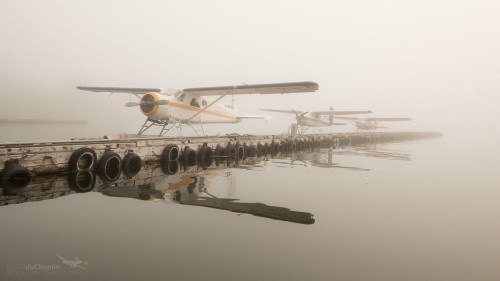 Three days is not enough for these adventures, even less so when Air Canada loses your luggage en route to Prince Rupert and you’re socked in by fog the first morning, but when we finally flew into the Khutzeymateen Inlet in British Columbia’s wild west coast, and began sitting with the grizzlies from our inflatable zodiac, it’s like time just stopped. Words can’t describe what I feel for these bears and the experience of being among them, in their home, but I hope the photographs can. Four of us chartered the Ocean Light II, giving us more room in the Zodiac (there are usually 8 passengers), and the ability to work with our guide, Tom, in a much more focused way. What a time we had. The golden bear you see in most of these images was amazing. We named her Bella and sat with her for hours watching her do her thing. She was patient with us, went about her day without giving any sense she minded us there, and seemed to welcome us when we returned looking for her the next day. In between there were crab dinners and long conversations, early morning kayaking, and the indescribable peace of a 6am coffee on the deck of the boat when others have not yet pulled themselves from their bunks.
Three days is not enough for these adventures, even less so when Air Canada loses your luggage en route to Prince Rupert and you’re socked in by fog the first morning, but when we finally flew into the Khutzeymateen Inlet in British Columbia’s wild west coast, and began sitting with the grizzlies from our inflatable zodiac, it’s like time just stopped. Words can’t describe what I feel for these bears and the experience of being among them, in their home, but I hope the photographs can. Four of us chartered the Ocean Light II, giving us more room in the Zodiac (there are usually 8 passengers), and the ability to work with our guide, Tom, in a much more focused way. What a time we had. The golden bear you see in most of these images was amazing. We named her Bella and sat with her for hours watching her do her thing. She was patient with us, went about her day without giving any sense she minded us there, and seemed to welcome us when we returned looking for her the next day. In between there were crab dinners and long conversations, early morning kayaking, and the indescribable peace of a 6am coffee on the deck of the boat when others have not yet pulled themselves from their bunks.
See images and articles about my last trip to the Khutzeymateen here, and also here.
I’m putting together a YouTube channel, hoping to release it later this month or in early July. It’ll be called Vision Is Better and is really just a way for me to engage with you in a different way without always having to write things down. The first couple episodes will be about this trip – if you’ve got guestions about gear, process, or Lightroom work, or something else related to this particular set of images – feel free to leave them below. I’d love to include some of them in the podcast.
June 12, 2015
Poetry & Imperfection
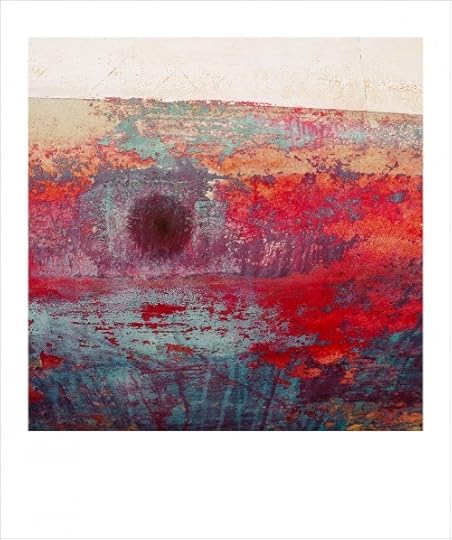 The third in a trilogy of opinionated editorial articles about getting past the craft in order to express vision. I’m heading back to the Khutzeymateen this weekend and have 3 days with the grizzly bears and the wilderness and with any luck the bee in my bonnet will take his leave and I’ll return with a renewed calm. This article comes, not from frustration at the industry (a rather vague entity) but from seeing the frustrations of my students, and the hesitance they exhibit in their work because they’re not sure they’re allowed to do the things they want to do. It is the tyranny of technical perfection and it’s killing our art.
The third in a trilogy of opinionated editorial articles about getting past the craft in order to express vision. I’m heading back to the Khutzeymateen this weekend and have 3 days with the grizzly bears and the wilderness and with any luck the bee in my bonnet will take his leave and I’ll return with a renewed calm. This article comes, not from frustration at the industry (a rather vague entity) but from seeing the frustrations of my students, and the hesitance they exhibit in their work because they’re not sure they’re allowed to do the things they want to do. It is the tyranny of technical perfection and it’s killing our art.
Poetry is not found in perfection. I’m not sure where I read that but it sticks beautifully to my thoughts about our addiction to technique. It is not that I’m saying we should abandon technique (I’m saying we need to go beyond it), but when it’s so relatively easy to get a photograph in focus and suitably exposed (compared to, say, learning to play the guitar with some competence, or learning to paint with oils) the question begs to be asked: where now?
You know how use your tools with greater and greater skill. But use them for what? What can I say to a student who shows me a truly perfect photograph that has no soul? This: now it’s time to breathe life into your work.
Now it’s time to change the question from, “How’s my my focus?” to “Is it alive?”
Sure, my colour temperature is perfect. But would less accuracy and more warmth make a stronger emotional connection?
Yes, I’ve managed to get rid of all the lens flare, but have I also rid the photograph of some intangible luminous spontaneity?
Has all that screwing around with buttons and dials brought me only to a perfect image of a missed moment?
You’re right, not a blown highlight to be seen, but have we gained detail that now only pulls the viewer’s eyes from the subject and towards something that does nothing but detract and dilute?
Our shadows are full of detail and for those who get excited about dynamic range, hurray! But have we lost the mystery? The pure form and abstraction of silhouette?
Our bokeh is gorgeous, so blurry and out-of-focussy and stuff, but have we lost (for example) the groom’s face in all that and rendered him an unimportant detail? Are we un-aware that we’ve come to rely on cheap parlour tricks?
I’m holding my breath, waiting for the noise to stop, for the collective head of the popular photograpy world, particularly those of us who teach, to emerge from our collective ass and to begin serving our students something they can can thrive on. The platitudes and simplistic rules aren’t doing it. So while I go blue in the face waiting for a change I don’t see coming down the tracks any time soon, to my students and friends, and anyone that wants to make a photograph that’s so much more than perfect: learn your craft, and then get past it. It’s there to serve you so long as it fits, not the other way around. It is a paint brush, and the practiced way you move it. That’s all. The painting is in your soul, your heart, your mind, not your camera bag.
The histogram is not a god. Your camera isn’t as smart as it thinks it is. And all the technical advice in the world is only worth the breath it took to say it if it creates an image that connects with me, that tells a story or sings a song, that is alive and makes you feel alive too. Chase emotion and life and mystery and joy and those things for which you first picked up a camera. The world is full of perfect photographs. Instagram is full of them. The world gets it, we have cool toys that paint with light. Now let’s make something full of life, something that is not only a record of an experience, but the gift of an experience. And that, friends, is found beyond the brand of the camera, the shape of the histogram, the size of your aperture, and whether some ding-dong on FB thinks your image doesn’t quite align to the rule of thirds grid.
Have a great weekend. I’ll say hi to the bears for you.
June 8, 2015
Stop Using A Camera, Start Making Photographs
The day my photography changed was the day I stopped learning to use a camera and started learning to make photographs. Indulge me: it’s more than just semantics, at least it was for me. We begin, most of us, learning photography as the art of using a camera, figuring out the buttons and dials and learning to focus and expose. It’s a first, necessary stage. And many, if not most, of us camp out there way too long. I did. We point our cameras at things, we expose, we focus, we press the button. And we wonder why, day after day, our photographs don’t get better. So we focus on the flaws, moan about the low dynamic range, or the high ISO noise, or the lack of edge to edge sharpness. Those things become our target in the ongoing quest for better photographs, because it seems so logical – if we use our cameras better, and we use better cameras, our photographs will get better.
“And many, if not most, of us camp out there way too long. I did. We point our cameras at things, we expose, we focus, we press the button. And we wonder why, day after day, our photographs don’t get better.”
Frankly, it was easier when photography was just that for me. I blame the poets and storytellers for pushing me further, for drawing me out of my technical pursuit and into something so much richer, but so much less tangible, and infinitely harder to pin down. They too master the technical stuff – the verbs, the grammar, the pens, the word processors. And they too have their share of very proficient word-users with nothing at all to say. And they too, regardless of what they call themselves, only make poems and stories that connect with us, when they get beyond the words and the writing itself, and say something. Using a pen is not the point, even using it really, really well, though if you use that pen better than most of your peers I suppose you might get an award and inspire others to use pens really, really well also. You might even lead workshops in pen-use, and write a blog. You could probably fill bookshelves with books about using pens. And you could do this without ever writing a poem, without ever writing a novel.
That was never enough for me. It’s not enough for me now, which is why I’m struggling so hard right now, and that struggle is most visible in my week-long absences from this blog. I write best when I’m creating. When I’m working. And I’m not there yet right now. I want to be. I want to be creating images underwater, showing others the whole worlds I’m finding in the emerald sea surrounding me on Vancouver Island. But I feel like the guy who was good at writing stories and decided to start writing poems, and despite all his time using a pen, he’s back at square one, trying to learn his craft and at the same time trying to understand his vision and find new ways to express it. Right now I suck so profoundly at all this that it’s taking all my energy just to gain competence. (My God, am I having fun, but making compelling photographs in this new way is a long way away!)
“But mere competence isn’t the point, is it? Don’t we want more?”
It’s easy to see how, once we reach competence we might just rest there, increasing that competence with magazines and YouTube tutorials, all of which have their place. But mere competence isn’t the point, is it? Don’t we want more? I guess we all do things for different reasons. For me, I want more than to use my camera really well. What I pursue is the visual poem or story, the final thing – something I have created – that does more than garner praise and collect various versions of the ubiquitous online compliment: “nice capture, man.”
“Be suspicious of thoughtless praise. When you want to learn, your more faithful teacher isn’t praise but constructive feedback from someone who is making art that’s stronger than yours.”
My point, which is dangerously close to another rant about the paucity of depth and substance in popular photographic education, never mind spirit and life, is that the moment you realize that you long for these things, and that they are found beyond competence with a camera, only then are you able to begin playing with light and lines and moments and the language of visual design, and that’s where the real journey begins. When you get there, if you’re not there already and a little bewildered about where to go next, here are three suggestions:
1. Study the masters. Put the camera magazines down. You don’t need another article of making tack sharp landscape photographs or 10 Reasons You Need Yet Another Lens. Study photographs. Stop asking which settings they used, and don’t order a Nikon just because Your Favourite Photographer uses one. Just study photographs. How do they make you feel? Why? How do they use lines? What decisions did they make that resulted in this photograph? What do they do that you do not? What can you learn? This is one of the chapters in The Visual Toolbox, and if you own that book, go back to that chapter – there’s a list of the photographers, among many, to whom I return constantly and keep learning something new.
2. Think about photographs as visual design. Stop obsessing about the gear and start finding excitement in finding great moments, new approaches to composition, and great light. If you’ve never picked up a book on visual design, consider looking at my book, Photographically Speaking, Michael Freeman’s excellent, The Photographer’s Eye, or Picture This, How Pictures Work, by Molly Bang
3. Go make photographs, and then study them in the same way you would study the masters – don’t seek compliments, and don’t ask your mom if she likes it. She loves it, but she might be not be the one to go to if you’re hoping to learn something you don’t know. Seek criticism from a source you respect. Avoid the online trap of mistaking likes on Instagram or Facebook for progress in your art. And when someone says, “I like it.” Ask them why. Don’t let them off the hook. How does it make them feel? Why? Be suspicious of thoughtless praise. When you want to learn, your more faithful teacher isn’t praise but constructive feedback from someone who is making art that’s stronger than yours.
June 2, 2015
The Place of Craft
“Sharpness is over-rated. No one has ever looked at the best photographs of this century and been moved emotionally because it was tack sharp or because the histogram was perfect. We suffer, not from a lack of technical ability, but from a lack of visual literacy, imagination, and the willingness to connect emotionally – and vulnerably – with our subjects.”
That’s what I wrote yesterday. It’s not new thinking for me, and if you come by here more than once in a blue moon, you know it’s old hat. Hell, it’s not even new thinking in the photography world. It’s a sermon that’s been preached for generations. What confounds me is that this always gets taken as a shot across the bow by a predictably small but vocal group who seem to have taken on the role of defending the pixel, lens, and sensor. Put the torches down, friends, I’m not starting a reformation, and I’m not denouncing your craft, though you might be holding it a little too tightly for your own good.
“There are plenty of genres in photography where sharpness, even the pixel itself, isn’t remotely a consideration. Those words don’t even enter into the vocabulary. We could stand to be a little less precious about it.”
The need for craft and technique is assumed. The need to use focus, exposure, and every other tool of the craft to make your photograph is assumed. It’s a starting point. It shouldn’t even need to be said. That’s why I don’t get bent out of shape about it. But it’s been assumed since we started this whole goofy process of painting with light. And tied to what is possible, and therefore to what some would call technical excellence, is the constant advancement of the technology itself. And that’s a good thing. But listen, in this context, it’s a means to an end. Nothing more. And it’s not even the only means to that end. There are plenty of genres in photography where sharpness, even the pixel itself, isn’t remotely a consideration. Those words don’t even enter into the vocabulary. We could stand to be a little less precious about it.
“The need to use focus, exposure, and every other tool of the craft to make your photograph is assumed. It’s a starting point. It shouldn’t even need to be said.”
Here’s what I wonder: could it be that those fastest to jump on the need for technical perfection (whatever the hell that means) are those for whom technical perfection is all they have? When we have nothing interesting or important to say with our photographs, and I’m talking in broad strokes as a community in this particular place in time, all we have left is “look how good my camera is.” I’m not sure the folks at Canon and Nikon squeal with conspiratorial delight when we say those things, but they sure don’t mind it and they love to quote us when we do. It keeps us distracted and addicted. Addicted to hope, the hope that the next camera will be sharper, bigger, faster, and that – abracadabra – our photographs will be better.
When we have nothing interesting or important to say with our photographs, and I’m talking in broad strokes as a community in this particular place in time, all we have left is “look how good my camera is.”
Better. I love that word. I love seeing people touted by others or their own PR, as “the best landscape photographer” or some version of the same. Better than you. Better than me. Nothing makes me want to drink gin from the cat bowl more than hearing about so and so who made this years best photographs in such and such a category. Move over, Fluffy, I’m draining this drink and calling for more, and then I’m going to figure out whether Monet was better than Picasso, whether U2 is better than Bob Dylan, and whether butterflies are better than birds, and pasta is better than pizza. Somewhere out there, right now, two nerds are gathered in their parents’ basement arguing about whether a tribble is better than an ewok. And you know who cares? Exactly.
Yes, clients want sharper and sharper images. Yes, the histogram matters, and no, we don’t want noise in our images either. But to a large degree these things don’t – they can’t – define what makes a good photograph, and I feel nothing but sadness for those for whom they do. Because they will never make a good photograph. Ever. Because the target keeps moving, and at a rate we can’t hope to keep up with. And so the image that’s good today will be too noisy, not sharp enough, not large enough, tomorrow. And the collection of images that were good today will become a collection of images that gets worse with time. And so they’ll buy bigger and sharper cameras, bankrolling the hope that the next one will be the quantum leap forward. And they’ll keep making sharper, larger, cleaner images. And that will be the best thing we can say about them. And you know who will care?
Exactly.
“Humanity doesn’t need more sharpness. That is not one of the things for which we hunger. We hunger for beauty, and meaning, for stories, and for love.”
Make your art with the tool you have. Use a Polaroid or a RED camera. Use film or digital. Use Leica lenses or Lensbabies. Create abstracts and impressionistic studies of shape and colour, or stunning landscapes that are tack-sharp @ 400%, but don’t kid yourself – it’s not sharpness that makes it great. It never has been. Humanity doesn’t need more sharpness. That is not one of the things for which we hunger. We hunger for beauty, and meaning, for stories, and for love – among other things, things that are communicated visually through light and composition – through our use of balance and tension and movement and scale and colour and a hundred other things that you can’t buy in the B&H catalog, and won’t be found in the manual of your new camera, no matter how much money you spend, no matter how much better your camera is than mine. We get it. Hell, every one of us has, right now, at least one camera that’s better than what every photographer who created a truly iconic image before the year 2000 ever had. You can make sharper, larger, cleaner images than any of them, together, ever made. And you know who cares?
May 25, 2015
The MOMENT Giveaway
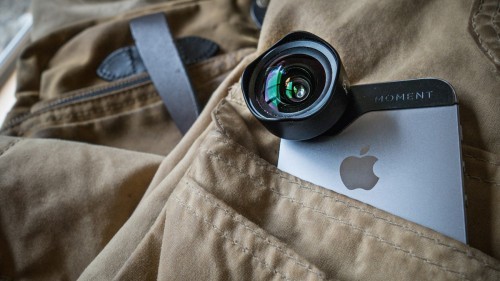 Your chance to win 2 lenses from Moment Lens Co., and a signed copy of The Visual Toolbox
Your chance to win 2 lenses from Moment Lens Co., and a signed copy of The Visual Toolbox
Last year one of my favourite new bits of gear was (still is) the wide-angle lens for my iPhone, from Moment Lens Co. They have two lenses for mobile phones – one gets you 2x wider, and the other 2x tighter – and the quality is excellent, which is what gets me excited. For my taste the iPhone lens (you can use Moment on a ton of different phones) is not wide enough for the kind of feel I want in my photographs, and a little too wide for what I like in my portraits. But the Moment lenses change that. They’re small enough to toss in your coat pocket and forget about until you want one, and they clip easily onto your phone with a clever little bayonet mount and a plate that adheres to the phone (and will last through foreseeable Apple upgrades so you don’t have to keep buying new lenses each time Apple changes its mind, just a new plate, and they’re cheap.) I love my iPhone camera, and Moment lenses give me more possibilities, which is why I love the iPhone in the first place – it’s brings play and spontaneity back to my photography in a way my larger cameras sometimes hinder.
Anyways, I’m a fan, and last week Moment touched base with me and asked if they could send me a couple lenses and I said I was grateful but what I’d really like is if they would send my readers a couple lenses and they were all over that. So. You know the drill. Check out their website. If you want a crack at getting a care package from the good folks at Moment Lens Co., just leave a comment in the comments below (sorry, RSS readers, you’ll have to come to the blog to do this) and let me know you want one. No restrictions on this one. If you’re in Timbuktu, we’ll send it to you as happily as if you were around the corner.
And because I always feel badly for the folks that don’t win, I want to send the winner, and 2 others, a signed copy of my latest book, The Visual Toolbox. I’ll do the draw on June 01, randomly choosing 3 names. Just leave a comment if you want in. And while I’ve got you here, if you’ve already read The Visual Toolbox, and you want a signed copy, I’ll throw in an extra one if you’ll leave an honest (but I hope enthusiastic) review on Amazon. Let me know you’ve left a comment on Amazon and of those who’ve done so, I’ll draw for one additional copy to be signed and sent to you.
Two Moment lenses, four copies of The Visual Toolbox, leave a comment here on the blog letting me know you’re in, and I’ll do a draw on June 01.
May 22, 2015
New Ideas, New Directions
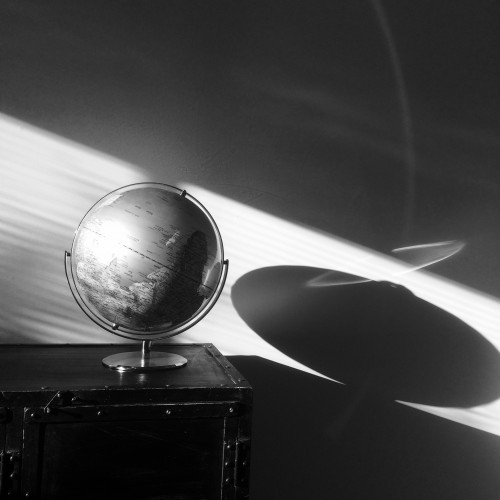
Today is one of those days. And this is one of those rambling posts. Feel free to skip it if you’re looking for something with a single coherent point that’s easy to follow.
We’ve just said goodbye to my mother at the airport and I’m settled on the couch in our new place in Victoria, surrounded by light and birdsong outside, books and notebooks surround me on the inside. I’m on the couch with a head cold so I’m doing my best to look pathetic and generate the odd sympathetic look from Cynthia. My head is filled, not only with this cold, but with ideas. Today is a day for catching up with emails, for reading, for coffee, naps, documentary short films, and for dreaming.
I spent 3 days last week at the E.G. Conference in Monterey. I was surrounded by astronauts, oceanographers, philanthropists, wildlife cinematographers, inventors, explorers, artists, and technologists. And my brain nearly exploded. How I will process all this I don’t know.
I’ve heard it said, and believe strongly, that if you’re the most interesting person in the room, you need to find a new room. We all need places where we don’t have a chance in hell of believing our own PR, where we’re surrounded by people with bigger ideas, different ideas, and stories grander than our imaginations. It’s these people that make us believe it’s possible to do more, be more, to stretch our hearts and our thinking beyond the bounds of our comfort or familiarity.
I think the same is true of anything we believe of ourselves. If you’re the most talented person in the room (whatever that means to you) then it’s in rooms where you are not remotely the most talented where you will learn and grow. It’s that idea of mastery being not a destination but a journey – the moment you think you’ve arrived you find that what you have in fact done, is stopped. Stagnated. Plateaued. Being at the EG Conference, I wasn’t even in the same universe as the most interesting people in the room, and it was mind-alteringly refreshing and inspiring.
It’s taken me to 43 years old to take this much delight in not remotely being the most interesting, talented, accomplished, person in the room. It’s all an illusion anyways, and the longer we believe these things about ourselves to keep intact our egos, the longer we are kept from the incredibly possibilities of being always a learner. I think it’s OK, even necessary to feel small and lost once in a while, in the presence of people that inspire us.
I think the single best thing you can do for your photography is not make it the single focus of your life, to expose yourself to new ideas, new directions, new means of expression, new people that challenge your ideas and keep you humble. Humility, curiosity, and creativity are a potent combination.
A couple days ago I relaunched a mentoring opportunity for my audience. Today I emailed a photographer I respect and asked him to mentor me. We never outgrow the need for people to speak into our lives and give us perspective.
There’s something about the creative process and the creative life that I adore for its unpredictability. We move from idea to idea and sometimes we take a hold of it, sometimes it takes a hold of us. Like a dance, it’s probably a little of both most of the time. And right now, after the last year, and the time I spent at EG, I feel like I’m swimming in deep, unfamiliar water, like some new idea – some big new thing – is circling me and no matter how fast I spin or crane my neck to catch a glimpse of it, it’s always just beyond my peripheral vision. I have hints. Hints like the question forming in my mind – as a humanitarian photographer returning to his childhood love for the ocean, what if saving the oceans is the single greatest humanitarian task of this generation? What does look like for my work? Who do I need to learn from, what new directions is this going to take me in? I have no answers, but I think specific answers are seldom the point. It’s the pursuit, the search, the new opportunities, that I relish. For the first time in my life, perhaps, not knowing is part of the joy.
May 20, 2015
We Should Talk (SOLD OUT).
Pour the coffee; let’s talk. (Before you read this and get excited, I need you to know it sold out. All the spaces were booked within 24 hours. Thank you so much for your confidence in me, I’m grateful and humbled and can’t wait to get working with you. If you missed it, we’ll be doing it again, just not too soon.)
It seems to me that once you read all the books and realize you’re reading the same stuff over and over again, you’ve outgrown that means of learning. Then what?
An obvious next step might be image critique, but from whom? Guidance about your work is only as good as the voices from which it comes, and only you know whom those voices should be. At very least they should be voices you respect, from people in whose work you see something you respect and in which you see something that suggests this person has something to teach you.
The same is true of business advice – it’s a dime-a-dozen, but how valuable it is to you will depend on the person from whom it comes. Are they doing business well, in ways you respect?
“David has been a constant voice in the development of my photography style, business, and voice, since the very beginnings of my journey as a professional photographer. There are many voices in this profession that ring true to me, but it was David I turned too when it felt like the hurdles were getting a little too high and a little daunting. His expertise as an artist, photographer and listener made a world of difference to me and I am delighted to have the opportunity to work with him one on one. “ ~ Vanessa Powell
Over the last year two questions keep colliding for me – one has come from you, the audience for whom I write and teach: Can you critique my work, mentor me, or provide business coaching? The second is my own question: how can I make myself available in a way that’s organic, that acknowledges that different people have different needs and don’t fit well into programs, and that acknowledges the reality we all face: that my time is limited and I can’t possibly respond to every request and still do so in a way that’s considered and thoughtful, and provides real value for those that are reaching out to me.
So this summer I’m going to try to answer both these questions by making myself available for one-hour blocks of one-on-one time on Skype. What you do with that time, is mostly up to you. It has to be, because only you know what you need. For some that will be a conversation about creative process and direction, for others it’ll be a conversation about your photographs, or a body of work. And for others still, it might be a discussion about branding, pricing, and marketing yourself.
“David invests in people. From the first minute I talked to him, I knew that he was truly interested in helping me achieve my goals. He is incredibly generous with his ideas, and he is great at breaking big, pie-in-the-sky type dreams down into actionable plans. This guy isn’t about toothless, inspirational quotes that will make you feel good and leave you wondering what to do next; he’s about getting stuff done.” – Graham Scobey
How long you want to engage in this kind of relationship is also up to you. If you’d like to talk to me four times over a couple months as we hammer out some direction and you work on some assignments, you can buy a Mentoring bundle. Or you can have one conversation and come back if and when you want to do it again. Image reviews would be a little different. You’d submit your images ahead of time. I would then spend 30 minutes recording a screen flow review of the work, send you that file, and then have a 30 minute conversation that comes out of that review, including suggestions for direction, creative exercises and assignments.
“Mentoring with David is one of the best things I’ve ever done for my photography. He’s been a trusted, guiding force who has helped me discover where my passions and strengths lie, and how I can best translate that into a business that works for me, and serves my audience with relentless dedication. He’s helped me truly follow my heart, and my work is more authentic and I’m more confident in it as a result.” – Kate Densmore
The obvious question is this one: how much? A one-hour session is CAD$300. Save 10% on 2 one-hour sessions, and a mentoring package of four hour-long sessions is $240/each (purchased as a bundle for $960 – saving you 20%). Securing your time will be simple, though limited to my availability – I’ve set aside only 20 hours on my calendar from June through August -, and once you’ve booked the time, my manager, Corwin Hiebert, will email you to schedule your specific time and give you more details.
Learn more at Craft & Vision / Summer Sessions.
NOTE: If you have a question or concern about booking a mentoring session please contact my manager, Corwin Hiebert, directly at: corwin@davidduchemin.com.
I know this won’t be for everyone, but for those that can take advantage of this, I am so looking forward to working with you. Once these summer sessions are over I’ve got some big blocks of travel planned, but intend to open another block of time in the new year, perhaps in March once I’m back from Africa and India.
May 12, 2015
Surprise! C&V Birthday Sale.
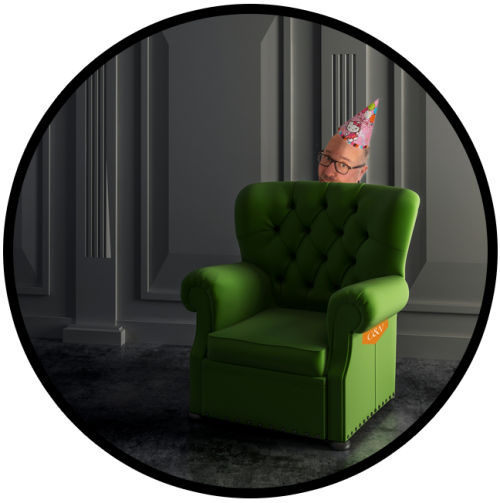 There are three things you need to know about surprise parties.
There are three things you need to know about surprise parties.
One: they happen when you least expect them (or they should. Let’s face it, few people can really keep a secret and they’re not much fun, therefore not the kind of person you want to throw a party for you).
Two: there will be gifts!
Three: OK, there’s really only two things you need to know. Did I mention the gifts?
Craft & Vision turns 6 years old this year, which means, according to the Internet’s collective wisdom on parenting, she’ll be uncoordinated and gawky but able to ride a bicycle. The perfect combination. The Internet also tells me she’ll have a tough time with choices because, well, she just wants it all. Don’t we all, baby. Don’t we all.
So in case you, like us, want it all, and also want gifts – SURPRISE! – we’re celebrating early. (That’s me hiding behind the computer-generated stock-photo chair, up top. I love surprise parties!) Starting right now and going until 11:59 PM (PDT) tomorrow night (that’s Wednesday, May 13) everything in the Craft & Vision store is 50% off, so you can get it all. And we’re giving away the first 4 issues of our beautiful PHOTOGRAPH magazine – for those of you that haven’t yet had a taste of it.
50% off some of the best photographic education available anywhere AND Issues 1-4 of PHOTOGRAPH are yours for free! Happy Birthday, Craft & Vision!
And if you already have it all, then grab a piece of cake and sit in the corner and talk amongst yourselves about how quickly she grew up and how soon she’ll be breaking my heart by running around with other eBooks twice her age, and experimenting with books about gear and spending her time arguing on forums about Canon and Nikon. They grow up so fast.
Thanks for all you’ve done to make Craft & Vision an inspiring place for photographic education. We couldn’t have made it without you!
PS – If you know others who love photography as much as you and I do, invite them to the party. The more the merrier – there’s plenty of cake for everyone. As long as they get here before Wednesday, May 13 at 11:59 PM (PDT).
May 8, 2015
Enough.
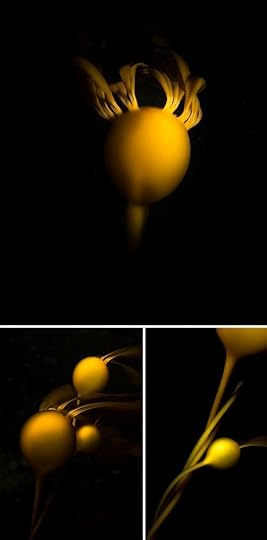 Bull Kelp, Queen Charlotte Strait, British Columbia
Bull Kelp, Queen Charlotte Strait, British Columbia
When I dropped into the waters of Queen Charlotte Strait a couple weeks ago it was a bit of a graduation for me. I’ve spent a year working towards it. Four different SCUBA certifications, a lot of reading, research, and far too much dreaming about the photographs I hoped I would make. And there was the gear. Figuring out housings and strobes and which part connected to what other piece. But I finally had it all together. So when, in the days before the trip I forced the lens port in a direction it didn’t want to go, and loosened it in ways it wasn’t meant to loosen, and then broke another piece because the directions were so poor, and then completely forgot a piece I really didn’t know I needed, it meant leaving my so-called big-boy camera on the shelf in my cabin while taking my little Sony compact with me instead.
I’ve toyed often with leaving my big gear at home and doing my work with smaller so-called entry-level cameras to make a point – the point being: the camera doesn’t matter as much as we like to believe it does. I say it alot, but maybe putting my money where my mouth is would convince the dubious. I never did, at least not to make a point. But when I took my Fuji gear with me to Kenya for my recent assignment in Kenya, and then my compact Sony because of this recent adventure in learning the hard way, and still returned with images of which I am as proud as any other work shot on cameras I once considered more serious, I started to think I’ve made my point as well as it needs to be made. And if you have eyes to see, artists all over the world do so everyday.
We all have raw materials and tools at hand. We have what we have. Some we have in abundance, some we have very little of. Money. Talent. Time. We’re constrained by life at home and emotional distractions and physical limitations. This, my dear friends, is life. We always have, and always will, make of it what we can, with the tools at hand. Or we won’t. But that’s our choice. There will always be something better, some tool or resource we don’t have. The great masters faced this same lack. And they still made do with what they had. All the advances in typewriters and paintbrush technology hasn’t made their work less powerful, less beautiful, or less meaningful.
You have everything you need to create something great. Something compelling. Something human, You also have what you need – the constraints – to make enough excuses to keep you from your work for the rest of your life, or to get creative and make something amazing. Something authentic.
I don’t know what you’ve been told, by your teachers, the guy behind the counter at the camera store, or that one a$$hole at the photography club, but you’ve got what you need. And you’ll grow into what constraints you have, and make something great not despite them, but because of them. Because you need constraints as much as – no, more than – you need a newer, shinier, better lens. Sure, we need the tools, but we need them much less than we imagine.
I can make art with my Sony RX100. And with my Fuji X-T1. Sure, I might make bigger art, sharper art, with this new camera or that pricey lens, and there are good reasons for doing so, but it’ll be no more compelling. It might even be less compelling, because when we rely more heavily on our gear than on our creativity, our work suffers. Our process suffers.
You’ve got what you’ve got, and for now it is enough. Go make something.





